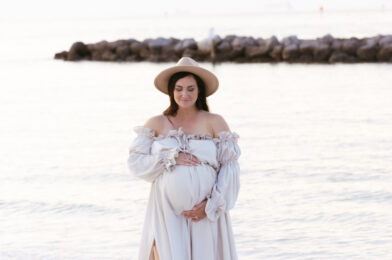Click here to read Part 1
For me to adequately give God the glory He deserves and highlight His great grace in Jonathan’s life, I wanted to explain more about those “mini storms” in this last pregnancy. I would say morning sickness is one of those “mini storms,” but after experiencing pretty crummy 1st trimesters with all of my pregnancies, I believe I managed to endure it fairly well. I was even able to volunteer at VBS at our church- helping lead the worship songs and dances- right in the middle of the nausea, fatigue, and occasional vomiting in the shower…all for God’s glory.
A couple weeks prior to that though, I got to experience the first AMA rainstorm regarding routine scans and tests per the prenatal care we decided was best for me. Without divulging too many details for the sake of privacy in our marriage, I want to first say that regarding my prenatal care and where I would give birth, Paul and I had to come to a compromise. Having experienced a traumatic hospital birth with Isaiah, a blissful birth center birth with James, then an unexpected, yet providentially guided hospital birth again with Jude in 2020 that came with complications and trauma of its own (click here to read more about that), finding a group of midwives (vs. a traditional OB) for my prenatal care that delivered at a very well-respected hospital here in Tampa was the middle ground for both Paul and I.
Because of my AMA label, a routine test and scan were done to ensure there were no genetic abnormalities (the risk of having a baby with Down Syndrome increases as the mother ages). I opted out of the genetic blood screening but chose to have the scan done that measured the fluid behind the baby’s neck (depending on the results, it can be a soft marker for Down’s). Immediately following the scan, I was told that all measurements looked great and was directed to head downstairs to the lab for 1st trimester prenatal bloodwork. After I finished getting my blood drawn, I was gathering my belongings and gathering my little ducklings to head to the van. As I got up from my chair, suddenly, I saw my midwife come from the elevators who just told me moments earlier that everything was “normal” and sent me on my way. Her countenance was now different as she hurriedly told me that the ultrasound tech “couldn’t find the nasal bone” and that “It would be best to get the genetic screening done…and if not, [I] could be referred to a genetic specialist.” Confused and having no clue what any of this had to do with seeing a genetic specialist, I told her that the tech had trouble getting a good profile so perhaps that is why she wasn’t able to see the nasal bone very well.
“It could be another genetic variant,” she kept saying. Trying my best to wrap my mind around what she was trying to explain to me, I agreed to getting the genetic blood test done since I was already there. When I got to the van, I started typing “no nasal bone” into the Google search bar and the next words auto populated…. “down syndrome.” I clicked on the first medical article from the NIH and the summary said, “The absence of a nasal bone is a powerful marker for Down Syndrome.”
My heart sank. Tearing filling my eyes, I immediately called Paul to update him on this whirlwind of such a confusing situation that just happened. I tried my best to avoid researching anymore when I got home, especially once I got the notification from my online patient portal that my appointment notes were available to view. I scrolled down and saw the words “absent nasal bone.” Paul and I continued to look over the ultrasound photos of the fuzzy profile, yet couldn’t really understand why the obvious white bone of the nose was considered “absent.” Every “normal” ultrasound photo of a profile we Googled looked just like ours. We just couldn’t understand it.
That night, a precious couple offered to watch the boys for us so that Paul and I could sneak away for a date night (completely unaware about what happened earlier in the day), but neither of us could get our minds off of the heavy news we received as we considered what our life might look like with a child with special needs. It was so overwhelming for me that I had a panic attack in the middle of the night.
The next day, knowing we wouldn’t receive the genetic screening results for probably two weeks, Paul uploaded the ultrasound photos of our sweet baby’s profile to a paid online health portal with a radiologist for a second opinion. The radiologist confirmed that he saw the nasal bone and was also baffled that they told us it was “absent.” Feeling a little more relieved, we anticipated the genetic screening results in the coming week or so. While waiting for the results, a message came through the online patient portal asking if I wanted to schedule an appointment with a genetic specialist as if they were already assuming there was something abnormal for certain. The message flustered me, but I declined the referral and waited on the test results instead, which much to our relief, stated there were no abnormalities.
Grace.
The pregnancy continued to progress beautifully as I gained more energy in my second trimester and was able to manage a solo 8-hour road trip from Tampa to Atlanta for the G3 conference to spend time with some sweet sisters in Christ as we learned about the beauty of the sovereignty of God.
In this pregnancy, I needed to be rooted in that doctrine more than ever.
Since I did not want to do the traditional glucose test at 26 weeks (I have a horrible migraine reaction to the Glucola drink and chugging 8 oz of grape juice wasn’t an option like it was with my birth center experience), I requested to check my blood sugar with a glucometer instead. What I wasn’t aware of is that I had to check my blood sugar four times a day for 2 weeks. Yikes!
Funny enough (or not so funny, really), in God’s providence, I would have to continue to do that up until the day that I gave birth! Yay, gestational diabetes diagnosis! 🙃 I received that diagnosis the same day that I would teach to a room full of 140 women at my church on the canon of scripture and the whole counsel of God later that night (all while my 5 year old couldn’t stop vomiting all day). Talk about a day that I needed to trust God for His peace!
The diagnosis officially put me in the high-risk category and was the hardest part for me at the end of the pregnancy, but again, in God’s sovereign providence, it forced me to pay careful attention to my diet and exercise (staying disciplined even through the holidays and my birthday), which I never really did with my other pregnancies. This meant that I didn’t gain as much weight, and I physically felt pretty amazing.
Grace.
So from November-January, I had to keep track of my glucose levels four times a day/seven days a week and send the numbers every Sunday night to the doctor assigned to me (a fetal and maternal health doctor that I only met once during a virtual visit). That part was honestly the hardest for me emotionally. I felt like I had to turn in my homework to my teacher, and if I was late in sending in my numbers, I would get a message to remind me and face the disappointment that my numbers were only slightly improving. My fasting glucose levels were the only numbers that were out of range consistently…but only slightly out of range; I struggled so much to get those numbers to change even with the diet and exercise changes and taking various supplements to help regulate my blood sugar.
Around week 34, I received a message in my health portal from a random nurse that said one of the doctors wanted me to start medication since my numbers weren’t decreasing as much as they would like. I immediately got flustered and responded letting her know that I would continue to monitor and regulate to the best of my ability with diet and exercise. In addition to the push for medication, they also wanted to make sure that his growth was on track because Jude was 9.6 lbs. and had shoulder dystocia. That was something that they would remind me of consistently. “We want to make sure he’s not ‘too big.’” Thankfully, his growth was great- he was only in the 35th percentile. Little did I know that they wanted me to have weekly scans up until birth. When I realized they were adding the scans to my already scheduled prenatal appointments, I politely declined.
Deep breaths, Emily…you’re almost done.
The next week I received the same message about being put on medication because the numbers were still slightly out of range. I got flustered again and declined the medication again. A few days later, I received a direct message from my fetal and maternal health specialist asking if I would monitor my glucose levels in the middle of the night around 2 AM for a couple nights to see where my levels were at. If the number was too low, then we know why my body was overcompensating with raising my blood sugar; if they were too high then we would know my body really was struggling to produce insulin at night. The first night, the number was way too high at 2am, which greatly concerned me. I agreed to try the medication so my body could finish strong, even though I absolutely hated the idea of taking medication while pregnant, not knowing how that would impact the baby’s growth and health.
But in God’s providence, the night that I took the medication, I discovered that I was in fact allergic- within 30 minutes, my lips, tongue, and face all went numb for three hours, but thankfully, didn’t get any worse. I would not have to take medication after all.
Grace.
Of course, once I told my doctor about the side effects, she advised me to not take the medication, but I wasn’t quite sure what to expect for the remainder of my pregnancy because they were beginning to talk about induction.
At my 38-week appointment, we agreed to one last growth scan to ensure that they could not push for induction based upon his size, so I had Paul come with me just in case that topic came up. The typical protocol for a gestational diabetes diagnosis is induction at 39 weeks. The midwife that I met with that day at my appointment was very understanding of my concerns and was in full support of seeing where things were at by 40 weeks (I had only gone a day or two past 40 weeks in the past so I was confident things would most likely go the same way this time around…my water broke with all of my boys).
Yet, I was still nervous as we neared 40 weeks; I did not want to be pressured into anything and wanted as many options available as possible. I began researching more about a natural induction method that I heard about regarding a foley balloon (Google it, it’s fascinating). I sent out a message asking about that method and was upset to discover that even if I chose that route, they wouldn’t allow me to go home to labor with it (some birth centers will let you go home with the balloon in place to labor at home), and they would still need to place an induction on the schedule (most likely to use Pitocin in case I didn’t progress with the balloon method). I did NOT want Pitocin. Even though I was beginning to have consistent contractions, I still felt stuck and unsure of what to do.
It was emotional for me, but I was trying my best to lean upon Him and take it moment by moment even with all the unknowns ahead. Yet, He truly was giving me His peace, and it wouldn’t be that much longer before I held precious Jonathan in my arms.
Grace.
I kept reminding my heart of God’s great sovereignty in all things. God was orchestrating all of this. Even in the difficulties, His grace continued to shine through.
Tagged : birthstory / faith / hope / motherhood / prayer / trust









